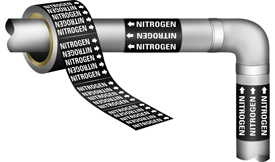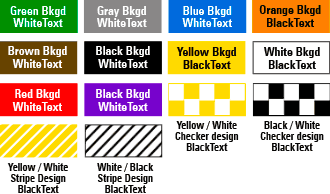MEDICAL GAS MARKERS INFORMATION
NFPA 99C 2002 Edition
- Piping should be labeled by means of metal tags, stenciling or adhesive markers that identify the medical gas or vacuum system.
- Pipe labels should show the name of the gas/vacuum system or the chemical symbol
- Color identification of piping used should be in accordance with the gases and colors indicated in CGA Pamphlet C-9
- Service outlets and inlets should be identified as to the name or chemical symbol for the specific gas or vacuum provided
Pipe labels should be located as follows:
- At intervals of not more than 20 feet.
- At least once in or above every room or area
- On both sides of walls or partitions penetrated by the piping
- At least once in every story height traversed by risers.
- Flow arrows should point from the station inlet toward the receiver or pump (Vacuum Systems)
- Flow arrows should point from the terminal to the vacuum producer (WAGD Systems)
CGA Pamphlet C-9 1988
This standard sets forth color uniformity for the identification and marking of medical equipment intended for use with specific medical gases. Colors shown on the table below should be used on containers which are intended for medical use color marked according to the gases they contained.
NFPA 99 TABLE 5.1.11 Standard Designation Colors and Operating Pressures for Gas and Vacuum Systems
| GAS SERVICE | ABBREVIATED NAME | GRAPHIC REPRESENTATION | MARKER COLOR(Background/Text) | STANDARD GAGE PRESSURE |
|---|---|---|---|---|
| Medical Air | Med Air | Yellow / Black | 50-55 psi | |
| Carbon Dioxide | CO2 | Gray / Black or Gray / White | 50-55 psi | |
| Helium | He | Brown / White | 50-55 psi | |
| Nitrogen | N2 | Black / White | 160-185 psi | |
| Nitrous Oxide | N2O | Blue / White | 50-55 psi | |
| Oxygen | O2 | Green /White or White/Green | 50-55 psi | |
| Oxygen / Carbon Dioxide Mixtures | O2 / CO2 n%(n is % of CO2) | Green / White | 50-55 psi | |
| Medical - Surgical Vacuum | Med Vac | White / Black | 15 in to 30 in HgV | |
| Waste Anaesthetic Gas Disposal | WAGD | Purple / White | Varies w/system type | |
| Other Mixtures | Gas A% Gas B% |
Colors as above (Major gas for bkgd / minor gas for text) | None | |
| Non-Medical Air(Level 3 gas-powered device) | Yellow with White diagonal stripe / Black | None | ||
| Non-Medical and Level 3 Vacuum | White and Black diagonal stripe / Black boxed | None | ||
| Laboratory Air | Yellow and White checkerboard / Black | None | ||
| Laboratory Vacuum | White and Black checkerboard / Black boxed | None | ||
| Other Mixtures | Red / White | 160-185 psi |
- Medical Gas Pipe Markers conform with the National Fire Protection Association Standard (NFPA 99C) and the Compressed Gas Association Standard (CGA C9)
- EZ medical gas markers were designed to wrap completely around 3/8" thru 2" piping.
- Markers are available in 2 different formats: Cards (Style M2 & M3) and Rolls
- Card Size M2 has one 4" x 7" marker. Use on 1" & 2" pipes.
- Card Size M3 has one 2-3/4" x 3" marker. Use on 3/8" thru 3/4" pipes.
- Rolls come with 100 markers @ 3" x 3" each. Use on 3/8" thru 3/4" pipes.
- Self-Adhesive Vinyl Labels
- All Markers include directional arrows
- Markers are available in a variety of different legends and colors.
- Durability: 4 to 5 years outdoors Mid Continental US
- Service Temp: -20 to 200° F
- Minimum Application Temp: 50° F
- Surface Prep: Clean & Dry
- Spec Compliance: NFPA 99C & CGA C-9
MARKER SIZE CHART
The following chart shows the recommended pipe marker size based on the outside pipe diameter of the pipe to be identified.

CARD FORM: SIZE 3
For pipes with O.D. of 3/8" to 3/4"
Legend Size: 3/8" High
Card contains 1 Marker at: 2-34 x 3" with Multiple Legends plus Directional Arrows

CARD FORM: SIZE 2
For pipes with O.D. of 1" & 2"
Legend Size: 1/2" High
Card contains 1 Marker at: 4 w x 7"h with Multiple Legends plus Directional Arrows

MEDICAL GAS MARKERS ON A ROLL
For pipes with O.D. of 3/8" to 3/4"
Legend Size: 3/8" High
100 Markers (plus directional Arrows) per Roll
Marker size: 3" x 3" (die cut for easy peeling)

LEGENDS & DIRECTIONAL FLOW
The standard regards the legend (wording on marker) to be the primary means of identifying the content of the pipe. The marker should give the name of the contents of the pipe in either the full name or abbreviated form. Arrows are also required to indicate the directional flow of the contents. Legends should be brief, pointed, and simple for greatest effectiveness. Contents should be identified with sufficient additional details such as temperature, pressure, etc., as are necessary to identify the hazard. Legends should be applied close to valves or flanges and adjacent to changes in direction, branches and where pipes pass through walls or floors; and at intervals on straight pipe runs sufficient for identification.








